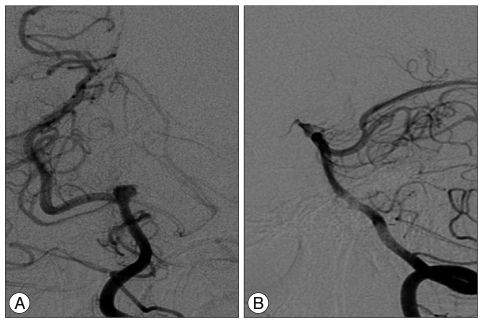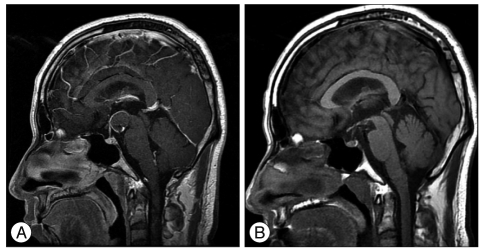J Korean Neurosurg Soc.
2012 Jan;51(1):62-65. 10.3340/jkns.2012.51.1.62.
Endovascular Treatment of a Large Partially Thrombosed Basilar Tip Aneurysm
- Affiliations
-
- 1Department of Neurosurgery, Dankook University College of Medicine, Cheonan, Korea. kimyj@dku.edu
- KMID: 2190478
- DOI: http://doi.org/10.3340/jkns.2012.51.1.62
Abstract
- Despite the remarkable developments in neurosurgical and neuro-interventional procedures, the optimal treatment for large or giant partially thrombosed aneurysms with a mass effect remains controversial. The authors report a case of a partially thrombosed aneurysm with a mass effect, which was successfully treated by stent-assisted coil embolization. A 41-year-old man presented with headache. Brain computed tomography depicted an 18x18 mm sized thrombosed aneurysm in the interpeducular cistern. More than 80% of the aneurysm volume was filled with thrombus and the canalized portion beyond its neck measured 6.8x5.6 mm by diagnostic cerebral angiography. Stent-assisted endovascular coiling was performed on the canalized sac and the aneurysm was completely obliterated. Furthermore, most of the thrombosed aneurysm disappeared in the interpeduncular cistern was clearly visualized follow-up brain magnetic resonance imaging conducted at 21 months. The authors report a case of selective coiling of a large, partially thrombosed basilar tip aneurysm.
MeSH Terms
Figure
Cited by 1 articles
-
Staged hybrid treatment for giant thrombosed fusiform aneurysm
Yunho Noh, Sung Ho Lee, Seok Mann Yoon, In Hag Song, Jae Sang Oh
J Cerebrovasc Endovasc Neurosurg. 2021;23(4):359-364. doi: 10.7461/jcen.2021.E2021.06.004.
Reference
-
1. Alvarez H. Etiology of giant aneurysms and their treatment. AJNR Am J Neuroradiol. 2009; 30:E8. author reply E9-E10. PMID: 18945792.
Article2. Aydin F. Do human intracranial arteries lack vasa vasorum? A comparative immunohistochemical study of intracranial and systemic arteries. Acta Neuropathol. 1998; 96:22–28. PMID: 9678510.
Article3. Bo WJ, McKinney WM, Bowden RL. The origin and distribution of vasa vasorum at the bifurcation of the common carotid artery with atherosclerosis. Stroke. 1989; 20:1484–1487. PMID: 2815182.
Article4. Cho YD, Park JC, Kwon BJ, Hee Han M. Endovascular treatment of largely thrombosed saccular aneurysms : follow-up results in ten patients. Neuroradiology. 2010; 52:751–758. PMID: 19921162.
Article5. Choi IS, David C. Giant intracranial aneurysms : development, clinical presentation and treatment. Eur J Radiol. 2003; 46:178–194. PMID: 12758113.
Article6. Ferns SP, Sprengers ME, van Rooij WJ, Rinkel GJ, van Rijn JC, Bipat S, et al. Coiling of intracranial aneurysms : a systematic review on initial occlusion and reopening and retreatment rates. Stroke. 2009; 40:e523–e529. PMID: 19520984.7. Ferns SP, van Rooij WJ, Sluzewski M, van den Berg R, Majoie CB. Partially thrombosed intracranial aneurysms presenting with mass effect : long-term clinical and imaging follow-up after endovascular treatment. AJNR Am J Neuroradiol. 2010; 31:1197–1205. PMID: 20299431.
Article8. Fiorella D, Kelly ME, Albuquerque FC, Nelson PK. Curative reconstruction of a giant midbasilar trunk aneurysm with the pipeline embolization device. Neurosurgery. 2009; 64:212–217. discussion 217. PMID: 19057425.
Article9. Iihara K, Murao K, Yamada N, Takahashi JC, Nakajima N, Satow T, et al. Growth potential and response to multimodality treatment of partially thrombosed large or giant aneurysms in the posterior circulation. Neurosurgery. 2008; 63:832–842. discussion 842-844. PMID: 19005372.
Article10. Jiménez-Heffernan JA, Corbacho C, Cañizal JM, Pérez-Campos A, Vicandi B, López-Ibor L, et al. Cytological changes induced by embolization in meningiomas. Cytopathology. 2012; 23:57–60. PMID: 21214650.
Article11. Kessler IM, Mounayer C, Piotin M, Spelle L, Vanzin JR, Moret J. The use of balloon-expandable stents in the management of intracranial arterial diseases : a 5-year single-center experience. AJNR Am J Neuroradiol. 2005; 26:2342–2348. PMID: 16219843.12. Kim SJ, Choi IS. Midterm outcome of partially thrombosed intracranial aneurysms treated with guglielmi detachable coils. Interv Neuroradiol. 2000; 6:13–25. PMID: 20667178.
Article13. Krings T, Alvarez H, Reinacher P, Ozanne A, Baccin CE, Gandolfo C, et al. Growth and rupture mechanism of partially thrombosed aneurysms. Interv Neuroradiol. 2007; 13:117–126. PMID: 20566139.
Article14. Lawton MT, Quinones-Hinojosa A, Chang EF, Yu T. Thrombotic intracranial aneurysms : classification scheme and management strategies in 68 patients. Neurosurgery. 2005; 56:441–454. discussion 441-454. PMID: 15730569.
Article15. Lubicz B, Leclerc X, Gauvrit JY, Lejeune JP, Pruvo JP. Giant vertebrobasilar aneurysms : endovascular treatment and long-term follow-up. Neurosurgery. 2004; 55:316–323. discussion 323-326. PMID: 15271237.16. Mansour N, Kamel MH, Kelleher M, Aquilina K, Thornton J, Brennan P, et al. Resolution of cranial nerve paresis after endovascular management of cerebral aneurysms. Surg Neurol. 2007; 68:500–504. discussion 504. PMID: 17597189.
Article17. Nagahiro S, Takada A, Goto S, Kai Y, Ushio Y. Thrombosed growing giant aneurysms of the vertebral artery : growth mechanism and management. J Neurosurg. 1995; 82:796–801. PMID: 7714605.
Article18. Saatci I, Cekirge HS, Ozturk MH, Arat A, Ergungor F, Sekerci Z, et al. Treatment of internal carotid artery aneurysms with a covered stent : experience in 24 patients with mid-term follow-up results. AJNR Am J Neuroradiol. 2004; 25:1742–1749. PMID: 15569740.
- Full Text Links
- Actions
-
Cited
- CITED
-
- Close
- Share
- Similar articles
-
- One Stage Operation of Triple Aneurysms: Case Report
- Woven Endobridge (WEB) augmented by Y-stent in a shallow basilar tip aneurysm
- Double Stent Assist Coiling of Ruptured Large Saccular Aneurysm in Proximal Basilar Artery Fenestration
- Giant fusiform aneurysm at the basilar trunk treated with endovascular coil occlusion following bypass surgery for the flow diversion
- Horizontal Stent Assisted Coiling of Wide Neck Basilar Tip Aneurysm: Comparison of Two Cases






